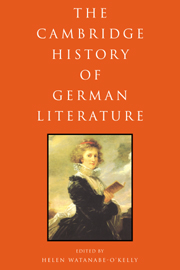Book contents
- Frontmatter
- 1 The Carolingian period and the early Middle Ages (750–1100)
- 2 The high and later Middle Ages (1100–1450)
- 3 The early modern period (1450–1720)
- 4 The German Enlightenment (1720–1790)
- 5 Aesthetic humanism (1790–1830)
- 6 Revolution, resignation, realism (1830–1890)
- 7 From Naturalism to National Socialism (1890–1945)
- 8 The literature of the German Democratic Republic (1945–1990)
- 9 German writing in the West (1945–1990)
- Select bibliography
- Index
- References
6 - Revolution, resignation, realism (1830–1890)
Published online by Cambridge University Press: 28 March 2008
- Frontmatter
- 1 The Carolingian period and the early Middle Ages (750–1100)
- 2 The high and later Middle Ages (1100–1450)
- 3 The early modern period (1450–1720)
- 4 The German Enlightenment (1720–1790)
- 5 Aesthetic humanism (1790–1830)
- 6 Revolution, resignation, realism (1830–1890)
- 7 From Naturalism to National Socialism (1890–1945)
- 8 The literature of the German Democratic Republic (1945–1990)
- 9 German writing in the West (1945–1990)
- Select bibliography
- Index
- References
Summary
Revolution: ‘Junges Deutschland’ and ‘Vormärz’
The nineteenth century was a time of enormous change in Europe, and nowhere was this truer than in Germany. Emerging from the Congress of Vienna in 1815 as a confederation of dozens of small states, Germany at last achieved nationhood in 1871. Similarly, the nineteenth century saw Germany move from a largely feudal, agrarian economy to capitalist means of production in a steadily more industrialised society. The middle class gradually emerged as a dominant force, first in conflict with the declining feudal nobility and then in tension with the rising proletariat.
The most volatile decades of this period were those between 1830 and 1850, when ‘revolution’ was a catchword of the day. The temper of the times is reflected in German literature, philosophy, music and art, which testify to at least four major kinds of revolutions: socio-political, sexual, religious and aesthetic. Regarding the first of these, the Revolutions of 1830 and 1848 were of paramount influence. Although Germany did not bring about a revolutionary upheaval in 1830, the 1830 ‘July Revolution’ in France, which replaced the Bourbon Charles X with the ‘Citizen King’ Louis Philippe and significantly strengthened the economic and political power of the bourgeoisie, added impetus to the German opposition to absolutist rule. Absolutism was personified in Klemens Metternich (1773–1859), the Austrian statesman who arbitrated the Congress of Vienna and, as prince, oversaw the so-called Holy Alliance, formed in 1815 between Russia, Austria and Prussia. Metternich’s name still symbolises the forces of reaction, since his regime functioned through a rigid system of censorship, espionage, imprisonment and exile that touched virtually all liberal-minded intellectuals.
- Type
- Chapter
- Information
- The Cambridge History of German Literature , pp. 272 - 326Publisher: Cambridge University PressPrint publication year: 1997
References
- 3
- Cited by



